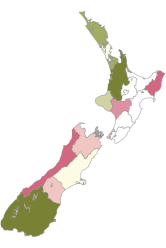
Key messages:
Everyone with diabetes needs regular access to eye services, but these services are not equally accessible to everyone in Aotearoa. Underserved populations include Māori and Pacific people, younger and older age groups (compared to people in their 50s), and those living in areas with higher deprivation. To develop more equitable services we need to collect better information on service access and outcomes for different population groups
Read the published paper and download a plain language summary of the findings.
About diabetes eye care
Diabetes can cause diabetic retinopathy—damage to the blood vessels at the back of the eye, which if not treated can lead to vision loss. Fortunately, regular retinal screening can detect early changes to the retina before vision loss occurs. In Aotearoa New Zealand, retinal screening is provided by the public health system and is usually recommended once every two years. People who develop diabetic retinopathy are referred to ophthalmology services for closer monitoring, or to receive treatment with laser or injections that can slow down the disease.
Why did we do this research?
To understand whether services are accessible to New Zealanders living with diabetes. Our aim was to identify any inequities in access to diabetes services between different population groups.
What did we do?
Using routinely collected data from 14 (of 20) District Health Boards that had provided data to the Ministry of Health, we identified everyone aged 15 years or over with a scheduled appointment at a diabetes screening or ophthalmology clinic between 2006 to 2019. We calculated how often people accessed diabetes eye care appointments, and whether there were any differences between genders, age groups, ethnicity groups, deprivation levels, and regions across Aotearoa.
What did we find?
~250,000 people had at least one scheduled diabetes eye care appointment between 2006 and 2019. Less than two-thirds (62.1%) of people accessed retinal screening every two years (as recommended).
A relatively low number of people never attended any retinal screening (1.5%) or follow-up ophthalmology appointments (0.8%) once they had been scheduled. Approximately 1 in 10 people (9.4%) accessing any diabetes eye care appointments received treatment (either laser or injections) for diabetic retinopathy over the study period.
Compared with NZ Europeans, Māori were about twice as likely to never receive diabetes eye care or to access ophthalmology when referred from retinal screening, and 9% relatively less likely to receive biennial screening. Māori received the fewest anti-VEGF injections when treatment was commenced
What is missing?
The available data had several limitations, which meant we could not estimate:
- How many people were never offered an appointment.
- A population-level national diabetic retinopathy screening rate.
- Outcomes from eye service appointments or barriers to access
Citation: Silwal PR, Lee AC, Squirrell D, et al. Use of public sector diabetes eye services in New Zealand 2006–2019: Analysis of national routinely collected datasets. PLoS One. 2023;18:e0285904. doi: 10.1371/journal.pone.0285904
